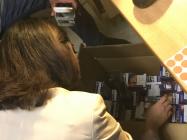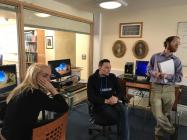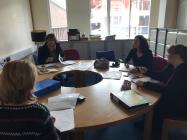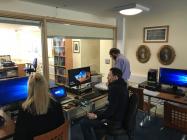Unlocking Our Sound Heritage - Reflections
Items in this story:
This story will have images of students from the Aberystwyth University who are studying an MA in Archive Administration carrying out different activities for The Story of Forest Project, which is a part of the Unlocking our Sound Heritage Project.
Reflections on The Story of the Forest Project:
The Story of the Forest represents a vital facet of Welsh history as it represents an auditory narrative which focuses upon the lives of those who worked within the Forestry Commission. The collection comprises of 167 mini-disks which contain interviews which primarily focus upon the work conducted by forestry commission workers and the communities they integrated into through working at the commission and through their own personal lives. As a result, these tapes are significant as they represent an insight into the tools and practices implemented by forestry commission workers which included tree felling alongside procedures such as fertilisation and road building. The interviews also represent an insight into the lives of young workers in a post-World War Two environment and detail their living conditions as well as their interactions with community figures. These interviews therefore represent a unique opportunity to provide a history of the region from ‘below’ by accounting for the perspectives of the workers as opposed to the official line established by governmental institutions such as the Forestry Commission.
However, there is a risk of obsolescence and degradation which threatens the oral histories provided within these mini-discs. Students on Aberystwyth University’s Archive Administration course were given the opportunity by the National Library of Wales to secure the future of the media by developing an exhibition at the bequest of the National Lottery Fund. The prerequisite to developing the exhibition included ensuring that digitisation was completed which would ensure that the audio on the mini-disc was secure from a preservation standpoint. Additional issues included ensuring that the interviewees had granted their explicit permission for the recordings to be released to the public, as well as providing transcripts of the digitised material. The primary intent of transcription is to ensure that a narrative can be established based from the people that lived around and worked upon the forest and in turn enables them to speak for themselves. The interviews draw on memories of not just the forest but also communities such as those at Hermon and Corris and as a result the exhibition incorporates photography to provide context to the oral history of the interviewees.
The project represents an opportunity for Archive Administration course members from Aberystwyth University to accrue practical experience within a record keeping environment. As a result, the exhibition will also document the learning experiences and processes associated with preservation and curating the stories for viewing by the public.
I chose to be part of the “Stories of the Forest” project team because it sounded both interesting and different. I love forests and liked the idea of helping to preserve oral heritage by being involved in a project relating to interviews about forestry in Wales.
My first task was cataloguing which involved inputting descriptive data about the interviews onto a spreadsheet. As part of the cataloguing process, I also had to add subject headings into the relevant columns. Subject headings are important as they describe what each interview is about and help people find the interviews they are searching for. After getting to grips with the cataloguing procedure myself, I then trained others in the group who then took over from me.
Digitising was the task I found most fun. This involved digitising the interviews which had been stored on minidiscs. Digitising was not a complex process but one that had many stages to it and one that required three computer screens. The computer screen at the back contained a spreadsheet which showed which minidiscs had already been digitised. The actual digitisation from minidisc to computer took place on the two screens at the front. One of the computers was connected to a minidisc player and this was how the interviews were loaded onto the computer before being converted to WAV format. The fun part was dragging the individual tracks of an interview from the second screen across to the first screen in order to connect them so that one continuous interview was created. This stage involved viewing the sound waves on the screen and clicking the play tab to check the sound quality.
I also did some transcriptions for the interviews that were in English. These were later added to the cataloguing spreadsheet in order to provide a fuller description of what was contained in each interview. Transcribing also helped identify some interesting interviews that could be used in the “Stories of the Forest” exhibition.
The success of any project involving teamwork depends on people communicating effectively and respecting each other. I feel that we did communicate effectively as we always managed to touch base at the beginning of a project session as well as at the end. As a result, we were clear on what we were doing and where we were going throughout the project. We also had a clear direction and clear goals thanks to our Project Leader, Stephen and thanks to the National Library staff who provided the help and support as well as the resources that we needed in order to complete the project.
All in all, it has been an interesting experience and I have learnt lots of skills that I didn’t have before, such as digitising sound recordings; transcribing interviews and learnt some project management skills too. It has been fulfilling in the sense that we have contributed to a national project which will benefit future generations.
Callum Harkins and Samantha West, Archives Administration Student, Aberystwyth University










